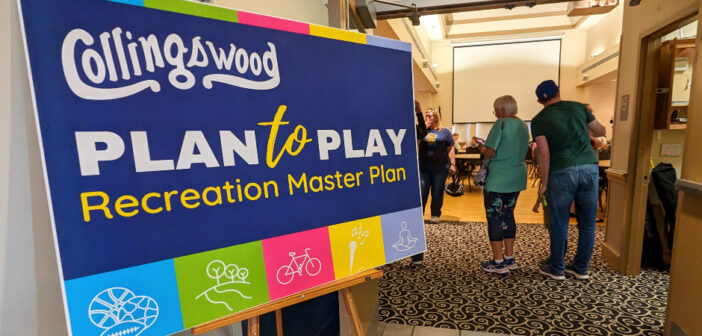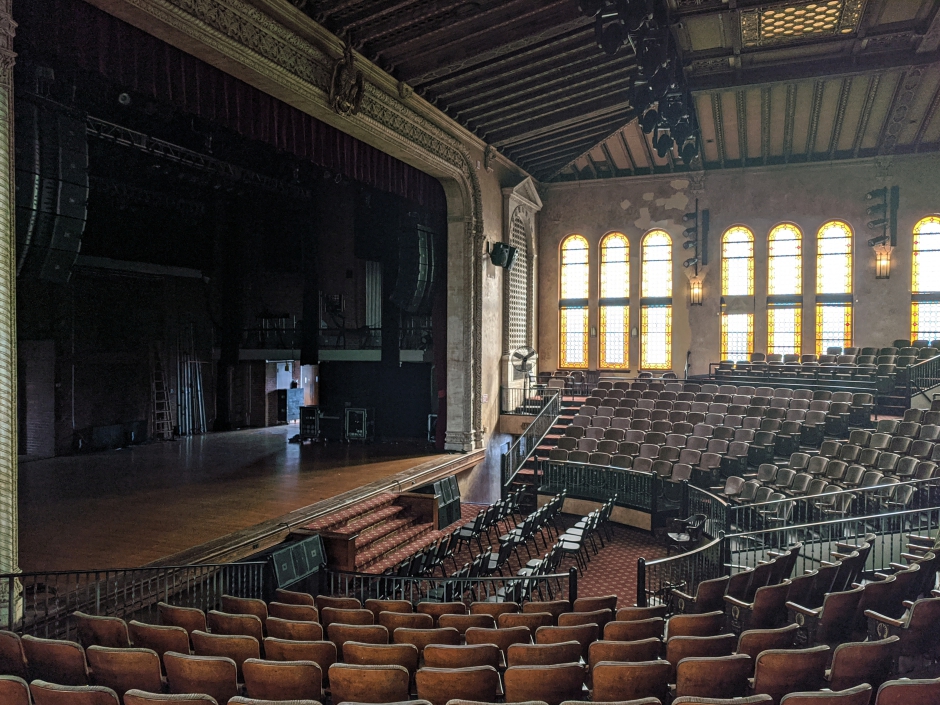The borough solicits resident feedback as it develops its blueprint for sharing community spaces this year. A first draft of the report is expected by the fall.
By Matt Skoufalos | April 30, 2023
For a town smaller than two square miles in area, the borough of Collingswood boasts a number of recreational amenities.
Knight Park, the 70-acre preserved space at its core, houses active and passive outdoor activities.
The adjacent, historic Scottish Rite Theater features community performances as well as those by national and regional touring acts.
Likewise, the nonprofit Perkins Center for the Arts supports those events, as well as fine and performing arts education.
In the summer, Roberts Pool welcomes locals and visitors alike to swim in its competition-length lanes, and enjoy its recently upgraded playground equipment.
The borough also borders the 346-acre Cooper River Park and its myriad uses; funds a local library once established by a Carnegie grant and a community bike share; and facilitates a number of broad community activities, including a celebrated seasonal farmers market, annual May Fair and Porchfest events, and holiday parades that draw visitors from across the region.
Securing the continued use of the facilities that support those activities, planning for their future preservation, and building capacity for new and expanded uses involves no small degree of forethought.
As such, the borough has begun work on “Plan to Play,” a new Collingswood Recreation Master Plan, the first draft of which could be released by year’s end. The master plan will be developed by architects Brandstetter Carol of Lexington, Kentucky, with project management, community outreach, and stakeholder coordination by SLK Partners of Collingswood.
Collingswood Mayor Jim Maley described the project as an opportunity to address a diversity of needs that intersect in shared spaces throughout the borough.
“We’re undergoing this project with our schools, groups with athletics, the arts, to try to look at how we can more efficiently plot out our space in order to accommodate as many different activities as we can,” Maley said.
Like many communities in South Jersey, the underlying circumstances complicating land use in Collingswood include its scarcity of open space, particularly as compared with the number of interested groups seeking space for their activities.
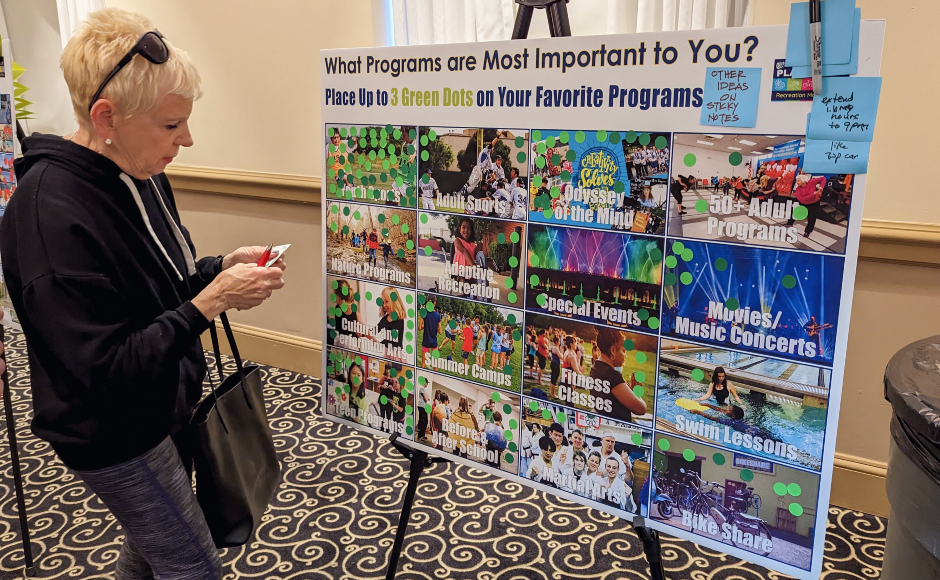
Guests at the Collingswood Recreation Master Plan event submit their feedback on the borough planning process. Credit: Matt Skoufalos.
The challenge the borough faces is how best to identify and meet the needs of each of these stakeholders in the most cost-effective way possible.
That’s why one of the first steps in drafting “Plan to Play” involved soliciting their perspectives.
In an event designed to gamify resident feedback, the community engagement process associated with the plan kicked off April 20, in a two-hour event at the borough senior community center.
Participants ranked their priorities by “voting with their dollars” in a sealed ballot-box activity, placing stickers on display boards with images of different recreational activities, listing the recreational features they currently enjoy the most, and answering open-ended questions about what they would like to see changed.
Between that event and the Collingswood Green Fest, which were held within two days of one another, the borough netted feedback from more than 400 in-person respondents and received 375 survey responses in total, Borough Administrator Cassandra Duffey said.
Outreach will continue throughout the spring and summer by way of additional workshops and surveys, Duffey said, and the borough has already solicited general feedback from 22 stakeholder community groups to start.
Among them was seven-year-Collingswood resident Devin Turner, Co-Chair of the Collingswood Green Team Bike and Pedestrian Committee. Turner, a bicycle and pedestrian safety advocate, said he’d like the recreation plan to consider accessibility as much as sustainability in its design.
“We’re talking about trails; it’s a great opportunity to look at the connections we can improve to our existing infrastructure,” Turner said.
“Newton Creek, Cooper River, Knight Park: we have these great resources,” he said. “But if you’re trying to get out there for your first time of the season, or your first time as a kid, it’s tough. [At Cooper River Park], those connections are significantly better on the Pennsauken side, so there’s definitely improvement to be done.”
Turner said he’d also like Collingswood to consider its place in the broader regional networks of the Camden Greenway and Camden County LINK Trail, which are recreational as well as transportation assets that also benefit from an infusion of county, state, and federal planning dollars.
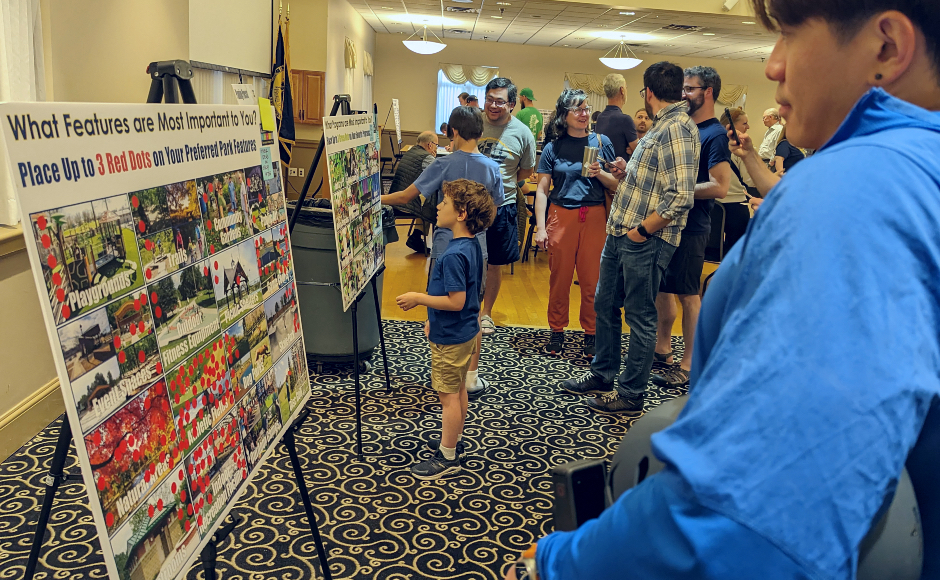
Residents participate in the Collingswood Plan to Play recreation master plan event. Credit: Matt Skoufalos.
“These are huge infrastructure investments we are making, and it’s a great opportunity for us to think about how do we leverage that as a community,” he said.
The question of sustainability touches environmental and economic community values, Turner said.
When considering which recreational facilities to build, he’d like the borough to consider their total usable lifespan as well as upfront costs.
Any overlap in form and function could help mitigate long-term maintenance while finding reuses for existing infrastructure, Turner said.
Working jointly with the borough gives the Collingswood public school district greater flexibility in redeveloping real estate on its middle and high school campus, where it is planning to replace athletic facilities demolished in 2018. That’s especially meaningful as the district continues to evaluate acquiring more classroom space and the cost of another bond referendum to do so.
“I would really like to see our community focus on [projects that support] multiple uses, and different uses at different times of the year,” Turner said.
“I would like to see Roberts Pool get different uses outside of the peak season,” he said. “There’s a great playground out there; it could be as simple as putting up a fence around the pool [to regulate access]. I’d love to see the Scottish Rite turned into a full-fledged venue.”
More than anything, Turner said he was excited to see how many different interests and uses residents were interested in developing in town, from organized sports to accessing local waterways.
“I love seeing this community engagement,” he said. “I think it’s brought a lot of great ideas and it’s a great opportunity for people to get their voices out there.”
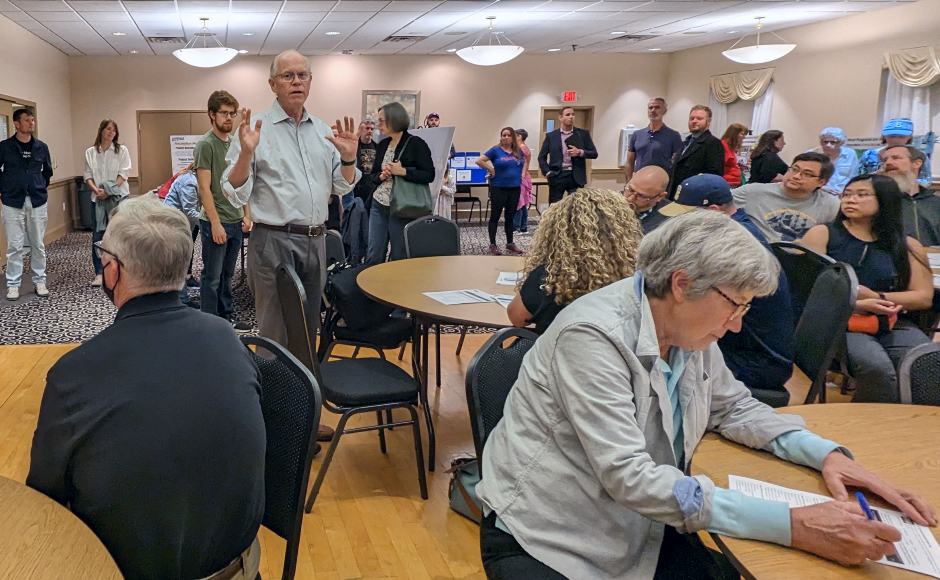
Collingswood Mayor Jim Maley addresses borough residents at a community recreation planning event. Credit: Matt Skoufalos.
Kenneth Allendoerfer, Collingswood Odyssey of the Mind cofounder and an engineering research psychologist, said the approach of gaming stakeholder input helps invite different perspectives through different participatory mechanisms.
What follows next will be the work of taking interests and needs and narrowing down solutions.
“You want people to go big before you get small; allow people a way to think about possibilities,” Allendoerfer said.
“The next part of the conversation is harder,” he said. “How do we narrow it down to the things that we want, what’s realistic, and what’s feasible?”
Even once the community has registered its input, and a plan is drafted, the question of how to cover the costs of implementing its solutions and measures still looms large.
At least in part, Maley believes that some of the major construction costs could be offset by leveraging private commercial interest in the borough.
Collingswood anticipates an influx of tax revenues from a number of redevelopment projects in the coming half-decade, including those at the Station House office building, proposed cannabis facilities along Route 130, and anticipated proposals for the OceanFirst Bank site at Haddon and Woodlawn Avenues, among others.
The mayor has suggested awarding PILOT agreements (Payments in Lieu of Taxes) on the value of these improvements, and then devoting “a substantial portion” of those revenues to help finance the recreation improvements.
“If we get a few in our books, that can be a mainstay to defray some of our long-term costs,” Maley said. “That’s the goal.”
Click here to participate in the Collingswood Master Recreation Plan survey.
Please support NJ Pen with a subscription. Get e-mails, or follow us on Facebook, Twitter, and Instagram.

